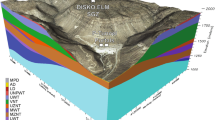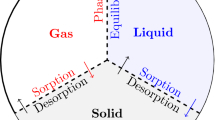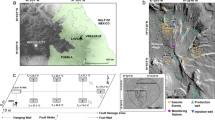Abstract
UNDERGROUND nuclear explosions produce trace amounts of distinctive but ephemeral radionuclide gases. In the context of monitoring a comprehensive test ban treaty, the detection of these gases within the territory of a signatory, during a challenge inspection1–5, may indicate the occurrence of a clandestine nuclear event. Here we report the results of an experiment simulating a well-contained underground nuclear explosion, undertaken to test the ability of natural gas-transport processes to move highly dilute and rapidly decaying radionuclides to the surface. We find that trace gases are transported to the surface within periods of weeks to a year, by flow along faults and fractures driven by barometric pressure variations. Both our observations and related simulations exhibit a chromatographic behaviour, with gases of higher atomic mass and lower diffusivity reaching the surface more rapidly. For a 1-kilotonne nuclear test under conditions identical to those of our experiment, we predict that short-lived 133Xe and 37Ar would be detectable, respectively, about 50 and 80 days after the detonation. Our results indicate that radionuclide sampling along natural faults and fractures, as a forensic tool, can be an extremely sensitive way to detect nearby underground nuclear explosions that do not fracture the surface.
This is a preview of subscription content, access via your institution
Access options
Subscribe to this journal
Receive 51 print issues and online access
$199.00 per year
only $3.90 per issue
Buy this article
- Purchase on Springer Link
- Instant access to full article PDF
Prices may be subject to local taxes which are calculated during checkout
Similar content being viewed by others
References
Hannon, W. J. Science 227, 251–257 (1985).
Zuckerman, L. Nature 361, 392–396 (1993).
Drell, S. & Peurifoy, B. A. Rev. nucl. Part. Sci. 44, 285–327 (1994).
Zucca, J. J. in Non-Proliferation Experiment: Results and Implications for Test Ban Treaties (eds Denny, M. D. & Stull, S. P.) 8-1–8-6 (Lawrence Livermore National Lab., Livermore, 1994).
Carrigan, C. R. in Non-Proliferation Experiment: Results and Implications for Test Ban Treaties (eds Denny, M. D. & Stull, S. P.) 8-51–8-62 (Lawrence Livermore National Lab., Livermore, 1994).
Baldwin, M. J., Bradford, R. P., Hopkins, S. P., Townsend, D. R. & Harris-West, B. L. in Non-Proliferation Experiment: Results and Implications for Test Ban Treaties (eds Denny, M. D. & Stull, S. P.) 5-1–5-20 (Lawrence Livermore National Lab., Livermore, 1994).
Pickles, W. L. in Non-Proliferation Experiment: Results and Implications for Test Ban Treaties (eds Denny, M. D. & Stull, S. P.) 8-63–8-70 (Lawrence Livermore National Lab., Livermore, 1994).
Maller, V. N. & Naidu, M. S. Advances in High Voltage Insulation and Arc Interruption in SF6 and Vacuum (Pergamon, New York, 1981).
Reimer, G. M. & Roberts, A. A. Bull. Ass. Petrol. Geol. Expl. 1, 1–17 (1985).
Nilson, R. H., Peterson, E. W., Lie, K. H., Burkhard, N. R. & Hearst, J. R. J. geophys. Res. 96, 21933–21948 (1991).
Reid, R. C., Prausnitz, J. M. & Poling, B. E. The Properties of Gases & Liquids 4th edn (McGraw-Hill, New York, 1987).
Forster, M., Maier, P. & Loosli, H. H. in Isotopes of Noble Gases as Tracers in Environmental Studies 63–72 (Int. Atomic Energy Agency, Vienna, 1992).
Smith, C. F. Project Gasbuggy: Gas Quality and Evaluation Program (UCRL 50635 Rev. 2, Lawrence Livermore National Lab., Livermore, 1971).
Scheidegger, A. E. in Mechanics of Jointed and Faulted Rock (ed. Rossmanith, H.) 3–35 (Balkema, Rotterdam, 1995).
Nitao, J. J. Reference Manual for the NUFT Flow and Transport Code version 1.0 (UCRL-ID-113520, Lawrence Livermore National Lab., Livermore, 1996).
Author information
Authors and Affiliations
Rights and permissions
About this article
Cite this article
Carrigan, C., Heinle, R., Hudson, G. et al. Trace gas emissions on geological faults as indicators of underground nuclear testing. Nature 382, 528–531 (1996). https://doi.org/10.1038/382528a0
Received:
Accepted:
Issue Date:
DOI: https://doi.org/10.1038/382528a0
This article is cited by
-
In-situ experiment reveals CO2 enriched fluid migration in faulted caprock
Scientific Reports (2023)
-
Molecular Dynamics Simulation of Pore-Size Effects on Gas Adsorption Kinetics in Zeolites
Clays and Clay Minerals (2023)
-
Fracture network flow prediction with uncertainty using physics-informed graph features
Computational Geosciences (2023)
-
Two-Phase Flow, Heat and Mass Transfer and Tracer Transport to the Atmosphere from Underground Nuclear Cavities Through Fractured Porous Media
Pure and Applied Geophysics (2023)
-
Evaluation of subsurface transport processes of delayed gas signatures applicable to underground nuclear explosions
Scientific Reports (2022)
Comments
By submitting a comment you agree to abide by our Terms and Community Guidelines. If you find something abusive or that does not comply with our terms or guidelines please flag it as inappropriate.



